
You might have noticed the top search results aren’t just links anymore.
That’s because Google search results are now full of many features, including the knowledge graph, people also ask questions, and one of my favorite features —the featured snippet.
Why do I love featured snippets so much? Because they provide readers with valuable information right in the search results, making them convenient and useful.
They aren’t just helpful for the average person, though. Featured snippets allow marketers to outrank competitors, boost conversions, and drive tons of targeted traffic.
In fact, the featured snippet is sometimes called “Position 0” because it shows up before traditional search results.
Here’s another reason why I love them: featured snippets account for 35.1 percent of total clicks, which means you need to optimize for them if you want traffic.
Want to snag the coveted featured snippet spot? Here’s what you need to know.
What is a Google Featured Snippet?
Featured snippets are extended search results that appear at the top of Google and provide users with a quick answer to their questions. Featured snippets are generally in the form of a list, chart, or video and often appear for informational or long-form search queries.
Rather than the standard one or two-line meta description, users see more text, sometimes including bullet points and longer explanations.
Here’s an example:
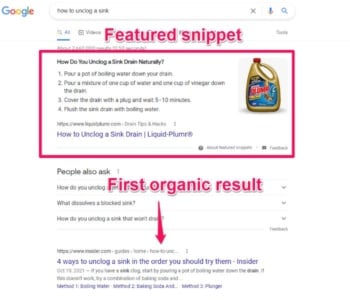
Just look at how much space a featured snippet takes up!
Featured snippets dominate the SERPs, occupying almost all the space above the fold in some cases.
They also give you tons of exposure, and keep your website visible. Plus, they’ll boost your company’s credibility.
The best part? You don’t have to pay extra advertising fees to rank for them.
You don’t have to be number one in your industry, either.
According to Getstat, 70 percent of snippets come from sites that aren’t in the top-ranking organic position.
Any company, regardless of size or budget, can earn a spot at position zero if you do it right.
What Are The Different Types of Featured Snippets
Nearly 15 percent of all U.S. desktop search results have a featured snippet—and not all of them are a list.
Featured snippets can also answer questions with an extended paragraph, like this:

There are also table and chart featured snippets.
Table snippets provide answers in the form of — you guessed it — tables. They usually look something like this:
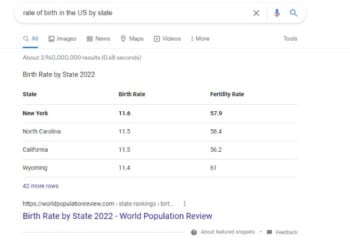
Note: There are other features, like rich answers and structured data, which change the look of your site in the SERPs. Those aren’t snippets, though they are closely related.
Tip #1: Use Google To Uncover Featured Snippet Opportunities
One of the best ways to find snippet opportunities is to think like your audience.
Snippets often show up for information and long-form search queries, so what questions does your audience ask?
Put yourself in the shoes of someone new to marketing who may not understand common terms or acronyms.
For example, I searched, “What is a CTA in marketing?”

There’s a featured snippet in the form of a paragraph.
Other terms you search might have a list—and who knows — the featured content might already be yours.
If it isn’t, check out ideas under the “People also ask” section.
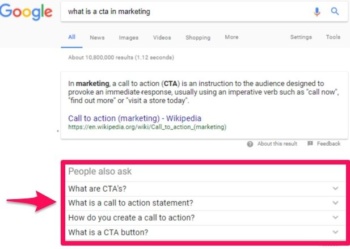
These are questions related to the search you already entered. Expand the phrase by clicking the arrows on the right and read the answers.
Next, you’ll want to update or create new content that provides the answer to the main question and people also ask.
When creating your content, be clear and two the point. The faster you provide the info users want, the more likely you’ll land the snippet.
Tip #2: Find Content Ideas On Answer The Public
Since questions are most likely to bring up featured snippets, focus on answering how, what, when, where, why, or who.
The best place to find out the types of questions people might be asking about a particular topic is Answer the Public.

Let’s say you want to learn more about crisis management.
Just type in your query, and you’ll receive tons of suggestions for questions related to the topic. Snag a few of those questions and answer them in your content.
Start by choosing which angle you want to take. In this example, I’d likely choose “what” because there are a lot of basic questions I can answer and probably grab the featured snippet.
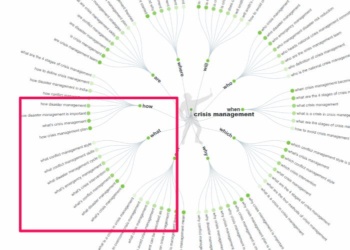
Keep in mind that you may want to do some keyword research before you do this to make sure the words you’re searching are SEO-friendly.
Tip #3: Do Keyword Research
Keyword research is crucial to landing those featured snippet spots.
It’s a good idea to use a keyword research tool or two to determine whether a search query will bring up featured results.
I like Serpstat because it lets me easily see which keywords bring up featured snippets on the results page.
Just type in a domain, keyword, or link, and hover over each result to see if featured snippets come up for each.
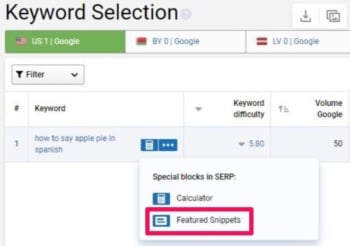
This is awesome for uncovering which featured snippets your competitors currently rank for.
Plus, if you already rank high for a particular keyword, you can see if Google currently brings up featured snippets for those keywords.
If they do, try to rank for it by identifying (and answering) the questions people have about that topic.
Then, just format your content to include tags related to those questions.
Tip #4: Answer Multiple Questions
I’ve found that once a page ranks for one featured snippet, it’s more likely to be featured in other related search queries.
That’s huge because it creates a snowball effect where you can earn more and more snippets.
Rather than working to optimize dozens of articles for snippets, aim to update a handful and really dig deep into the answer.
Define main terms, explore steps if the topic lends itself to that format, and answer as many of the “people also ask” questions as you can.
This creates a highly valuable piece of content that both users and search engines will like.
Tip #5: Stay Within The Optimal Word Count
Featured snippets are longer than your standard search result, but they also aim to answer users’ questions as quickly as possible.
Keep your section tight and concise so that Google can easily feature your content.
Section off your lists, paragraphs, and steps rather than letting them all run together.
Just look at this list — it’s only 52 words long!
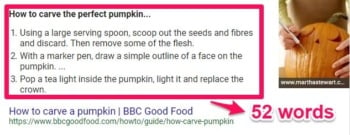
According to Semrush, this is a normal length for a featured snippet. Their analysis found that “[t]he most common length of content in featured snippets is between 40-50 words.”
Due to this, aim to keep each content section no longer than 50 words and no shorter than 40.
Tip #6: Use Headers
Headers often appear as a larger font used to break up sections in content. On the back end, they use HTML to tell Google the importance of each heading.
In Google Docs, click “normal text” and choose headings from the drop-down. H1 is your title, H2s are for main points, H3s are for supporting points under H2s, and so forth.
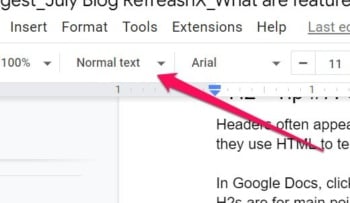
If you add “Step 1, Step 2” or “Rule 1, Rule 2” to each heading phrase, Google will place them in chronological order if you snag a list snippet.
Tip #7: Add A “How-To” Section To Your Website
Another way to snag snippets is to add a how-to section to your site. Since so many featured snippets cover detailed informational content, you have a far better chance of landing the coveted spot 0.
Some websites are creating entire sections on their sites that are specifically for giving answers to their readers’ questions.
Here’s how Lowe’s is doing it with their “DIY Projects & Ideas” section:

Creating a section on your site makes it easier for users to find your content that solves specific issues.
If you don’t want to create a “how-to” section, a Q&A or frequently asked question section could also work. Just remember to keep the content short and answer questions fast.
Tip #8: Add High-Quality Images And Video
Many people learn visually, so adding photos and images can help you rank for featured snippets. (Google also includes images in featured snippets, which takes up more SERP space!)
Adding images to each step is quite simple using a tool like Canva. Their library has tons of stock photos, templates, and many icons you can use to create professional-looking images quickly.
Even better, you can use it to create videos. Here’s an example from their video template section:
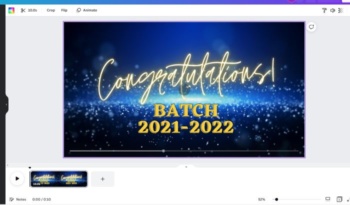
According to Video Explainers, sites that use video are 53 percent more likely to show up on the first page of Google.
Trying video marketing is worth the effort, and it’s easier than ever with Canva or your smartphone.
A simple way to improve video performance is to add voice transcripts for all your videos. Google recognizes the text and might choose it for a featured snippet.
You should also make sure that your video content is high quality.
I try to add transcripts for almost all of my videos, like this one:
I then add the full transcript below the video in the description.
FAQs
Featured snippets are expanded search results that answer users’ questions right in the search results. Featured snippets can be lists, paragraphs, or charts.
No, Google chooses the most relevant source as a featured snippet; it is not an ad.
To land featured snippets, aim to answer questions quickly, use headers, and stay within 50 to 60 characters. Answering questions in the “people also asked” section of Google for your keyword can also help.
No, featured snippets are expanded search results selected by Google. Structured data is a way to organize and code information on a page so Google can better understand the information.
Conclusion
Trying to keep up with Google can be absolutely exhausting.
But featured snippets aren’t going anywhere. In fact, they’re on the rise, and that means pages with featured snippets are dominating search queries.
They’re the first thing that comes up in most SERPs, and they’re more than just plain links.
Earning a featured snippet means you rank for position zero, which is the highest ranking spot possible without advertising.
If you want to boost conversions, drive visitors to your website, and beat your competition easily, ranking for featured snippets is the answer.
from Neil Patel's Digital Marketing Blog https://ift.tt/m42FapX

No comments:
Post a Comment